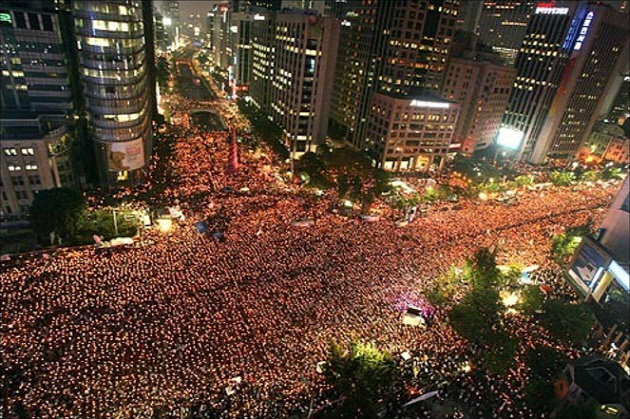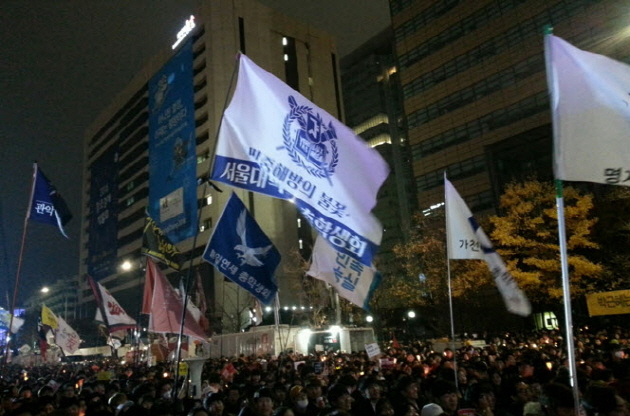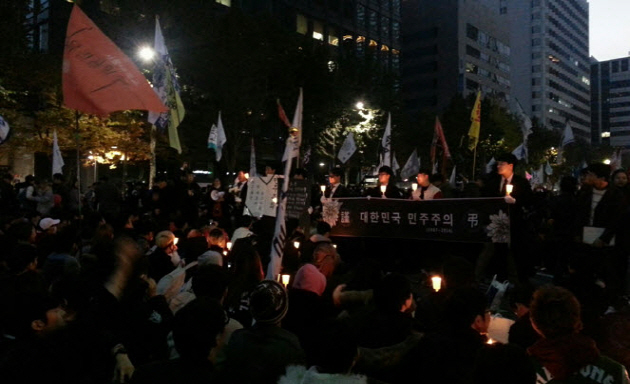
An aerial view of the candle protest on November 26
November is a month of relaxation, after the October midterms and before the December finals and end-of-semester deadlines. An ideal November weekend would consist of sleeping in late, catching up on recent movies, chatting with friends in a cozy café and enjoying the bright blue autumn sky while it lasts.
But this past November was somewhat different. For three Saturday evenings in a row, I headed to Gwanghwamun, in central Seoul, more than an hour and a half from my home. I wandered around streets full of bustling people and constant noise, standing outside in the cold for many hours. I returned home at midnight on a crowded subway, having to stand the whole way. I was happy to endure these hardships, in order to attend the nationwide protests held amid the ongoing presidential scandal. The weekly trips to Gwanghwamun were exhausting, but they left me with several experiences that I will always remember.
Feeling the Diversity
Before the protests, the impression I had of Gwanghwamun was an open, tranquil area. In my mind Gwanghwamun Square was usually empty save for two, hulking statues of King Sejong and Admiral Yi Sun-sin, two of Korea’s historic hero-figures.
But the Gwanghwamun that I experienced during the past few weeks was completely different from the image I had before; it was alive with the diversity of the population in today’s Korea. I saw all sorts of people: university students like myself, parents with children in strollers, teenagers walking with friends, elderly citizens led by their sons and daughters, journalists making live reports, foreigners living in Korea, out-of-state citizens asking for directions, street vendors selling snacks and candles, and so many more. In every direction I looked, the streets were packed with people constantly moving around, holding flags and placards of all shapes and sizes. I will never forget how the protest scene was so vibrant and so full of energy. My perception of Gwanghwamun has now changed, from a symbol of tradition to a symbol of modern dynamic spirit.
Peaceful and United
I had almost forgotten how passionate and united Koreans can become when we are motivated enough. So many people joined the protests that most of the subway stations in the area, such as Gwanghwamun, Gyeongbokgung, Jonggak and City Hall, were overloaded with people. It felt almost ten times worse than the usual rush hour, and simply walking out to one of the exits took several minutes. During peak hours around 6 p.m., subways carried so many passengers that for safety reasons, trains would pass through some stations without stopping, causing people to join the main protesting area from one or two stations away.
Despite the sheer size of the crowd, the protests were remarkably organized and peaceful. With more than one million people in a limited amount of space, it was sometimes nearly impossible to move from one location to another. Still, people patiently made their way to their respective destinations, squeezing themselves through small spaces without a complaint.
When protest organizers suggested a “candlelight wave,” people stopped milling about and held up their candles or smartphone lights. For the “lights-out” performance, the entire crowd waited for the signal and blew out their candle lights at once.

SNU flag in the demonstration march
Using Technology to Count the Crowd
The estimates of the size of the crowd provided by the police and those provided by the protest organizers vary widely. No one will ever know exactly how many people came to each of the protests, but there are several ways to estimate the number using state-of-the-art technology.
The method used by the police to come up with the number of protest attendees is to calculate crowd size at a certain specific point in time. The police assume that one pyeong (about 3.3 m2) accommodates nine to ten people when standing up and four to five people when sitting down. Then they multiply these numbers each with the respective total approximated area within Gwanghwamun Square.
However, such method does not take into account the fluctuating number of people, as not all people attend the protests for the entire day. Another limitation is that during the most crowded peak hours, about 15 standing people fit into an area of one pyeong, as demonstrated by some documentary producers.
Nowadays, there are more technologically advanced ways of estimating crowd size.
One approach is counting the number of subway passengers exiting at stations within the protest area, as most protestors living in or near Seoul go to Gwanghwamun via subway. Another approach is counting smartphone signals. With the exception of very young children, most Koreans carry smartphones, each of which has its own unique signal code. A third option is to count candle lights by scanning a high-quality photo of the site. This method uses the same technology that counts the number of stars in the night sky. According to “candle counting,” participants of the fifth national protests (November 26) number around 1 to1.3 million.

SNU students in the protest
Anyone Can Become a Speaker
In various locations within the Gwanghwamun area, there were huge broadcasting trucks with amplifiers and megaphones. Most of the time these trucks were used by protest organizers who led chants and marches, but sometimes ordinary citizens were given opportunities to speak to the crowd nearby. Anyone could volunteer to climb up on the truck, hold a microphone, and express their opinions. Some speakers gave impromptu speeches while other speakers came with their speeches written and prepared, but regardless of format, every speaker received attention and enthusiastic support. Mothers, office workers, high school students and even elementary school students bravely declared their beliefs to the crowd, which ardently cheered in agreement.
You are not Alone
Although many people join the protests with family members or friends, not everyone can find a Gwanghwamun buddy. Of course, it is absolutely fine to participate alone: Emboldened by the bursts of chanting and marching, anyone can overcome the awkwardness and feel united with strangers nearby. University students can also choose to join the group of their fellow university students, led by the members of the student council. There, you may be able to find friends you didn’t know were coming.
As for myself, I was able to find fellow “loners” in an open KakaoTalk chat room created among fellow SNU students and alumni. Although none of us knew each other when we first gathered at a nearby subway station exit, we got along very well for the rest of the day because we were all SNU students or alumni wanting to participate in the candle protests.
The open chat room also provided real-time information about where the SNU Student Council is at the moment. From what I remember, the number of members in the chat room reached almost 700 at its maximum. So there is no need to worry about walking around alone, because once you arrive at Gwanghwamun, it is not too difficult to find someone to join the protest with.
Written by YOON Jiwon, SNU English Editor, jiwonyoon@snu.ac.kr
Reviewed by Professor Travis Smith, Department of Asian Languages and Civilizations, tlsmith@snu.ac.kr

